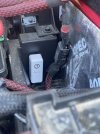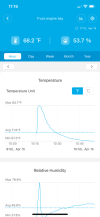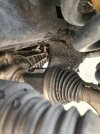I replaced my stock battery with a dual purpose (starter and deep cycle) lithium (LiFePO4) battery. Dakota Lithium 135Ah, 1000 CCA. I need to do some more testing with it and tweak some IBS parameters with JScan, but so far, so good.
I went with Dakota Lithium over Antigravity for three main reasons: Capacity (135Ah vs 60 or 80), it's self heating for charging in the cold, and price—though it still wasn't cheap! But the Antigravity would have a much easier install, since it's available in the same H7 size of the stock battery. The DL is a Group 24F size battery (same depth, but narrower and taller than than H7).
I may do a more detailed write up later of the install process, but the short version is, I had to cut and splice two 2 AWG wires and one 4 AWG wire and crimp new battery lugs. Fortunately, I have a hydraulic crimper already, so this wasn't too bad. Just a major leap of faith when you make that first cut.
I am a bit concerned about how heat under the hood will impact the battery. I'm also concerned if my eTorque DC-DC charger could ever provide too much current to the battery; it's best to charge it lower than 40A, and 135A is the maximum sustained charge. I'll keep an eye on charging current and temperature.
The battery has Bluetooth (oddly, they don't advertise this), and you can use their app to track current, voltage, state of charge, and other parameters. Oddly, it doesn't display temperature, though since it has a self-heating feature, it must include a thermometer. But, you can monitor battery temperature from the IBS via JScan.
During my first test drive, before I tweaked any IBS parameters in JScan, it mustly didn't charge. Rather, during this evening trip (thus, headlights and taillights on), it was must draining at around 20A. It did see it charging as high as 80A for a brief moment; still safe, but higher than I like.
Since then, I tweaked the IBS settings, especially setting the battery voltage at which it'll be recharged; it defaults to 10V, which is a very dead LFP battery. I changed it to 13.4V, just below the fully charged, resting (i.e., not currently charging) voltage of an LFP. What this means is, the charger will kick in earlier and more often, but, I believe, at a lower current. (Ohm's Law also plays in here: LFP batteries internal resistance rises with voltage, so current will drop as voltage rises).
I haven't yet taken another test drive after these tweaks, but I'll be keeping an eye on things this week.
(The finally install is the one with the black felt on top and the wires wrapped in loom).
View attachment 181094
View attachment 181093
View attachment 181096View attachment 181095


















